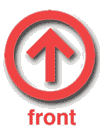
This is the fourth week I've written about the cool box of bones I got as a present through the post. I've already written about the leopard skull, the boa constrictor skull and the monkey skulls, and this week this week I'm going to write about the bird skulls !
• The goose skull

Duck and goose skulls are really easy to spot, but there are loads and loads of different types. This skull didn't have a label, and I checked against my mallard skulls and my pink-footed goose skull and it looked different.
I used skullsite.com, which is a really good website for bird skulls, to work out what it was. I knew this skull was 118mm long, but that's not a big help because a lot of goose skulls are about the same size, so I went through all the goose skulls looking for one that looked the same, I was most looking for one with a bump at the back of the braincase, and the same holes between the eye sockets.
I worked out it was a greylag goose. Here's the page for that skull on skullsite.com.
• The short-eared owl skull

This skull came with a label on it, which said "short-eared owl". I checked skullsite.com and the picture for short-eared owl looked exactly the same, so I think the label is right.
The label also said: "Found Bridgend, Islay, 1995". (Islay is one of the Scottish Islands). It's a great skull, especially as I have a barn owl skull already, but the beak on the short-eared owl is a lot shorter.
• The herring gull skull

 This is another skull that had a label on it which made it easy for me to work out what it was. The label said "herron gull", but it was misspelt so I couldn't check it on skullsite. But when I typed in "herring gull", it came up with this page which looked exactly the same. The skull on that site though is bigger than mine; their skull is 124mm and mine is only 108mm.
This is another skull that had a label on it which made it easy for me to work out what it was. The label said "herron gull", but it was misspelt so I couldn't check it on skullsite. But when I typed in "herring gull", it came up with this page which looked exactly the same. The skull on that site though is bigger than mine; their skull is 124mm and mine is only 108mm.There are two typed of herring gull, an this skull is a European Herring Gull. They are sea birds. There is something that seabirds have which you can see on this skull. There are grooves above the eye sockets which are where the salt glands go, where the birds get rid of excess salt from the sea water. This is something I learned from doing Paolo's Mystery Object every Friday.
• The small raptor skull

Raptors are birds of prey and their skulls are easy to spot because of the short beak with a hook at the end. I knew this skull was from a raptor, but I didn't know which one. I thought it was too small to be a grown-up raptor because it was only 45mm long, but when I looked on skullsite.com there were raptors which had skulls this small like Hobbys and Merlins.

UPDATE, October 2012: I got an email from Wouter van Gestel of skullsite.com who said the skull wasn't a buzzard but was a sparrowhawk ! Because of the size I think it is a female.
There are so many different types of bird skulls, and it's great to have some new types. I am really pleased to have more skulls in my collection !
Enjoy this post ? Share it !






















0 comments :
Post a Comment